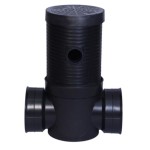Inspection chamber
Advantages of the plastic Inspection Chambers
• Application
The Inspection Chambers have a universal application as they can be installed in rainwater and domestic wastewater collectors and in industrial drainages.
• Evacuation
The connections are done directly to the plastic pipes, without the need of any type of adaptor. The hydraulic properties of the chambers assure that there isn’t any reduction in the transportation capacity of the system.
• Design
The design of the Inspection Chambers is based on an experience of many years in the market of the sanitation.
These chambers have been developed to solve the serious problems that there are in the sewerage networks, such as:
– High phreatic levels
– Anchor
– Resistance to collapse
– Infiltrations
– Longevity
– Hydraulic properties
– Obstructions
• Properties of the material
The material of the Inspection chambers is PE or PP, which are ideal for applications in areas of drainage and sewerage. Within the advantages of this material it can be highlighted its high chemical and mechanical resistance as well as its excellent behaviour before the high temperatures (PP). The manufacturing process is through Injection or Rotational moulding.
• Waterproofing of the System
The waterproofing of the whole system is guaranteed by the perfect tightness of the joins to the Inspection Chambers. This allows decreasing the volume of the fluids in the treatment plants due to the elimination of the infiltrations of parasitic waters towards the inside of the collector system.
• Depth of the installation
The Inspection Chambers are usually designed and tested to be able to be installed up to a maximum depth of 4 m.
• Advantages in the installation
– Lower Weight.
– Drastic reduction of the time of installation.
– There is no need to use cast concrete with the following save of setting time.
• Advantages of the System
It is very easy to handle, transport and to install, so it means a reduction of the final cost of the project.
It is adapted to the movements of the soil without losing the tightness of the system, achieving a totally reliable and secure system.
Showing the single result
